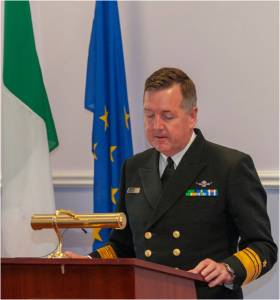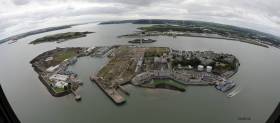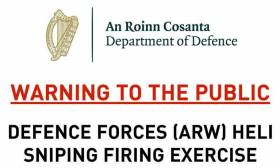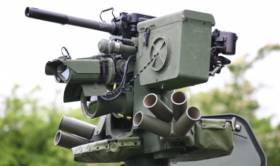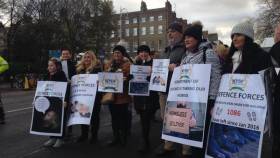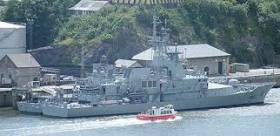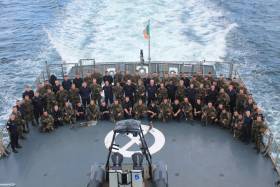Displaying items by tag: Defence Forces
Chief of Defence Forces On a Mission to Modernise
#navy - The Irish Times writes that it is the breaking down of barriers which is central to what Mark Mellett sees as his role as Chief of Staff of the Defence Forces.
The obstacles are within the Defence Forces itself and between them and the outside world.
He believes that the way to penetrate these resistant mindsets is through strategic and mutually beneficial engagement with academe and the private sector, on the one hand, and also by the Defence Forces participating – in keeping with government-determined policy – in military initiatives further afield.
Having risen through the ranks of the Naval Service to senior command and taken part in several high-profile operations (including recovery work in the wake of the Whiddy Island oil ship explosion disaster and Air India jet crash off the west coast), Vice-Admiral Mellett, who has a doctorate in political science, began to think more than a decade ago about leadership on a larger playing field.
To read more comments from the Chief of Staff click here.
Group Representing Defence Forces ‘Not Confident’ of Pay Rise
#NavalService - Organisation that represents Defence Forces officers says it doesn’t have confidence that the Public Service Pay Commission (PSPC) will deliver much-needed pay increases for lowly-paid sailors, soldiers, and aircrews.
As the Irish Examiner writes, the warning from Raco (Representative Association for Commissioned Officers) comes after many hard-pressed Defence Forces families were forced to rely on charitable donations of food hampers to get them over the Christmas period.
Raco general secretary, Commandant Conor King, said little had changed for the lowest paid public servants since Nasa (National Association of Army Spouses) took to the streets 30 years ago to highlight the deplorable pay and conditions endured by military personnel.
Comdt King said Nasa’s actions gave birth to the founding of his own military representative association and that of sister organisation PDForra, which represents enlisted personnel.
He said the recent Respect and Loyalty parade outside the Dáil, organised by veterans, and the founding of the lobby group Wives and Partners of the Defence Forces (WPDF) showed that little had changed since 1998.
Click the link here for further reading on the story.
Defence Forces Head Seeks to Address Commission Directly Over Pay
#NavalService - The Irish Times writes that the head of Defence Forces has sought to make a verbal submission to the Public Sector Pay Commission because of the seriousness of the military pay issue in the view of himself and senior colleagues.
Chief of Staff of the Defence Forces Vice Admiral Mark Mellett declined to use the word “crisis” saying he preferred to say the military was facing serious “challenges”.
He was speaking on Tuesday before addressing the annual conference of PDforra, the Defence Forces’ rank-and-file representative body, in Castlebar, Co Mayo.
His remarks came in the wake of two Naval Service vessels being unable to put to sea last week (see Afloat's related coverage) because of crew shortages, and reservists being used to fill crew gaps on another vessel.
The problems prompted Vice Admiral Mellett and his assistant Chief of Staff, Brig Gen Peter O’Halloran, to hold emergency talks last Friday with the Naval Service Flag Officer Commanding, Cdr Mick Malone. For much more from the newspaper click here.
Also the story appears in The Irish Mirror which adds that morale is at an all-time low in the Naval Service with 66 sailors staying on board their ships because they can’t afford high rental prices.
The revelation was made by Mark Keane, president of PDFORRA, the organisation that represents members of the Defence Forces. Mr Keane lifted the lid on the discontent in the ranks at the naval base on Haulbowline Island in Cork Harbour.
For further reading including comments made by the president also speaking at the conference held in Mayo, click here.
Naval Service Vessels Kept At Base Due To Crew Shortages
#Navy - According to The Irish Times, two Naval Service vessels were prevented from leaving their Haulbowline base last week due to crew shortages.
The LÉ Orla and LÉ Niamh were both kept at their docks while reserve members were drafted to cover shortages on the flagship LÉ Eithne.
Last week’s situation — linked to a reduced level of personnel retention — is a symptom of a bigger problem within the Defence Forces, The Irish Times reports, with one lieutenant colonel saying the command structure “is breaking down”.
The Irish Times has much more on the story HERE.
Calibre of Defence Forces Recruits ‘Reduced’
#NavalService - The Irish Examiner writes of a damning report that highlights the reduced calibre of recruits in the Defence Forces, concluding that some had severe learning difficulties, others were extremely unfit, and one had been arrested numerous times by gardaí.
Some officers within the Defence Forces have queried vetting procedures as the report claims they were unaware of that person’s past until it was pointed out by another recruit.
Garda vetting is not carried out in many cases before recruits are inducted into training. This is because of the need to speed up recruitment to replace the haemmorage of highly trained personnel who are leaving the Defence Forces for better pay and conditions in the private sector.
Garda vetting of recruits can take between three and six months to complete.
For more on the newspaper's story click here.
Live Heli Sniper Firing Exercise Now Under Way
#MarineWarning - The Defence Forces Training Centre is conducting two days of heli sniper live firing exercises in Gormanston Ranges as of this morning, Wednesday 18 July.
As previously reported on Afloat.ie, the danger area includes the air and sea areas contained within a radius of 3 nautical miles centred on Gormanston Aerodrome.
The danger zone also includes an area contained within a segment centred on Gormanston Aerodrome, with a bearing of 15 degrees true through Mosney Railway Station and 106 degrees true through Gormanston Railway Station, seawards for a distance of 10 nautical miles.
For the periods while the range is active, the sea zone within the danger area is excluded to all vessels.
Live Firing Practice Off South West Coast This Week
#MarineNotice - The Defence Forces will be conducting surface and air live firing practice shoots in Sea Area South South West (D13) between Seven Heads and Galley Head and to seaward between Tuesday 26 and Thursday 28 June from 8am to 6pm daily.
The danger area comprises the sea area contained within the co-ordinates detailed in Marine Notice No 27 of 2018, a PDF of which is available to read or download HERE.
While the range is active, this sea area is out of bounds to all vessels. A Naval Service patrol vessel will enforce the exclusion zone ‘D13’.
All vessels are required to remain outside of the exclusion zone while the range is active, and are also recommended to carefully monitor the radio navigation warnings that will be broadcast during the firing period.
#Navy - More than 100 people writes RTE News have taken part in a protest over pay and conditions for rank and file members of the Defence Forces.
The demonstration was organised by the Wives & Partners of the Defence Forces (WDPF) group.
A wreath was laid at the national memorial at Merrion Square in honour of deceased Defence Forces members.
Members of the Irish UN Veterans Association, which organised the ceremony, then took part in a march to Leinster House.
Family members of Defence Forces personnel addressed the crowd outside the Dáil.
After the demonstration, a smaller group resumed a vigil and will stay outside Leinster House overnight (last night).
The WPDF supports the families of enlisted Defence Forces personnel. To read more scroll down the page beyond second photo.
#navy - Concerns have been played down by the Taoiseach as to the number of personnel quitting the Defence Forces has left the combined strength of the Army, Air Corps and Naval Service at a 50-year low.
As The Irish Times writes, a high turnover is a normal feature of military organisations, Leo Varadkar said on Tuesday, as it emerged that more than 1,000 members have paid to leave the Defence Forces over the past five years.
The Fianna Fáil leader, Micheál Martin, noted in the Dáil statistics from PD-Forra, the largest military staff organisation, that 2,900 people had taken early retirement and 1,000 had paid the State a “discharge purchase”, averaging €300, to leave before their contracts expired.
Mr Varadkar reiterated the Government’s commitment to ensuring a full strength of 9,500 personnel and said 800 would be recruited this year. About 580 people leave every year, and “that’s been the case for the past decade”. The Taoiseach said “other military, such as the United Kingdom, are experiencing similar issues”.
To read more and that of the response of PD-forra, which represents sailors, airmen and soldiers, click here.
Recruits Required for Defence Forces But Amid Concerns Over Troop Numbers
#navy - A new recruitment competition has been opened by the Defence Forces writes The Irish Times, but this is amid concerns over dwindling troop numbers in the military.
Announcing the recruitment drive on Wednesday, Minister of State for Defence Paul Kehoe said the move “reflects the Government’s commitment to meeting the Permanent Defence Forces strength targets”.
A recent report commissioned by the Defence Forces found it is now at a “critical point” with staff numbers well below the target of 9,500.
The report, compiled by researchers at the University of Limerick, noted that figures for unit sizes were often embellished as the absence of members on leave, long-term training courses or overseas missions was not taken into account.
Mr Kehoe said previous recruitment campaigns will deliver more than 800 new Defence Forces personnel by the end of this year, although it is not known exactly how many new staff are proposed to be taken on as part of the latest wave.
“This general service recruitment campaign will build upon the successes of previous recruitment campaigns from which it is expected that just over 800 new personnel will have been inducted into the Permanent Defence Force by the end of 2017,” he said, adding: “As this will deplete existing panels, it is now appropriate that we initiate a new campaign in order to provide for the induction of further personnel in 2018.”
The newspaper has much on this story, to read click here and information on datelines for applicants wishing to join the Defence Forces including the Naval Service.



























